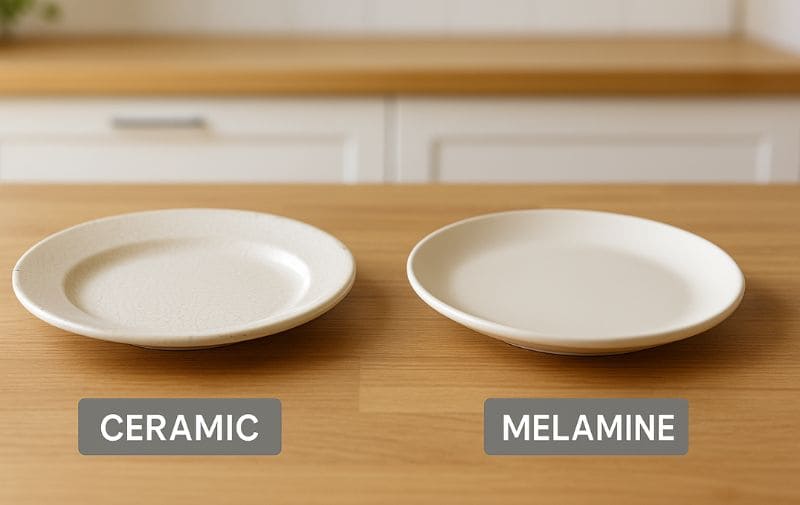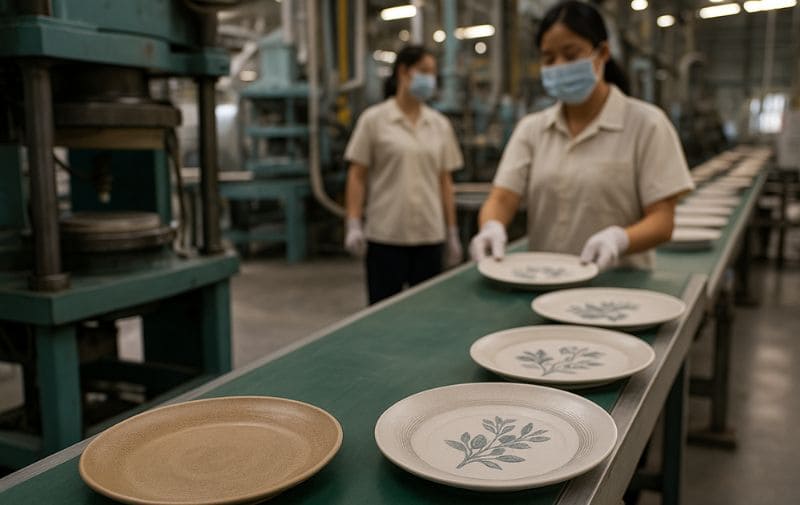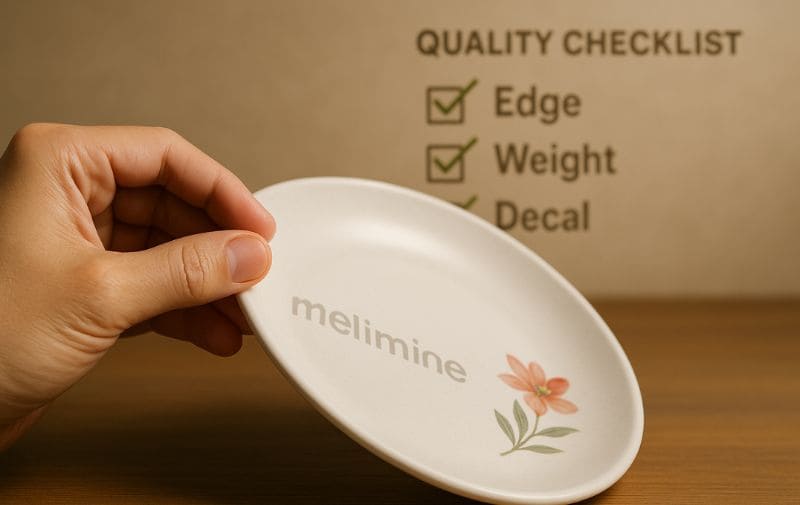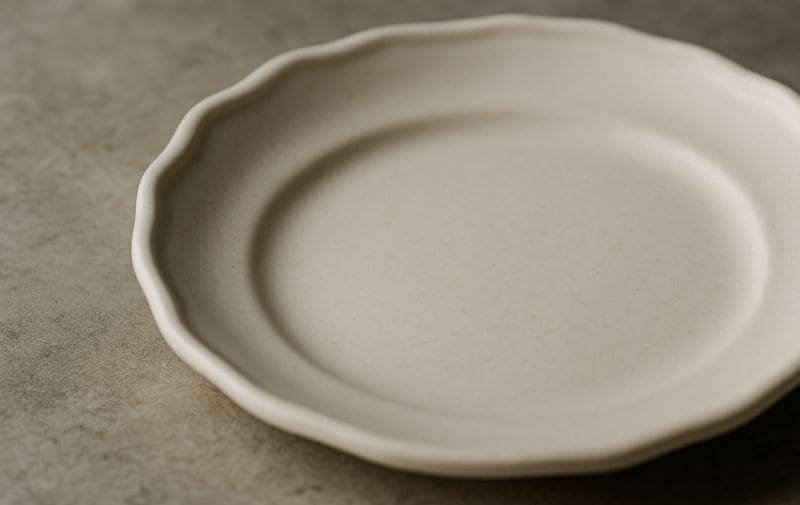You’ve seen the term “melamine ceramic” online or in a catalog and it stopped you in your tracks. It sounds like the perfect hybrid material, but what is it? You’re left wondering if it’s a new technology you’re missing out on.
“Melamine ceramic” is a marketing term, not a material. These plates are 100% high-quality melamine, but they are manufactured using advanced techniques involving special molds, textured finishes, and sophisticated decals to perfectly mimic the look and feel of real, artisanal ceramic dinnerware.
Now that we’ve cleared up the biggest point of confusion, let’s get into the fascinating details. As someone who works with this material every day, I want to pull back the curtain on how factories create this beautiful illusion. It’s a story of solving a major problem for restaurants and hotels: how to get the stunning aesthetic of ceramic without the constant breakage and heavy lifting.

Let’s Clear the Confusion: Are Melamine Plates a Type of Ceramic?
You see a plate that has the rustic edges and speckled glaze of hand-thrown pottery, but it doesn’t break when you drop it. It’s natural to be confused.
No, melamine and ceramic are fundamentally different materials. Melamine is an organic-based thermoset plastic, while ceramic is an inorganic, non-metallic solid made from baked clay. The term “melamine ceramic” simply describes the plate’s style, not its composition.
Understanding this distinction is the first step to becoming an expert buyer. You’re not buying a hybrid material; you’re buying intelligently designed melamine. The two are worlds apart in their physical properties, which is precisely why ceramic-look melamine is so popular in demanding environments.
The Fundamental Difference: A Side-by-Side Look
| Feature | Melamine | Ceramic |
|---|---|---|
| Core Material | Organic thermoset compound (resin) | Inorganic, non-metallic solid (clay) |
| Key Property | Shatter-proof and highly durable | Brittle and prone to chipping/breaking |
| Weight | Lightweight and easy to handle | Heavy, can cause server fatigue |
| Heat Insulation | Poor heat conductor (plate stays cool) | Good heat conductor (plate gets hot) |
| Common Use Case | Restaurants, hotels, outdoor dining | Home use, fine dining |
As you can see, their core characteristics are opposite. This is why a hotelier’s dream is to get the visual appeal of ceramic with the operational benefits of melamine.
How Do Factories Make Melamine Look and Feel Like Real Ceramic?
So if it’s not ceramic, how do manufacturers create such a convincing fake? It’s a sophisticated process that goes far beyond just printing a pattern onto a plate.
Factories use a three-part strategy: specially designed molds with organic shapes, advanced surface finishing to create matte textures, and multi-layered decals that replicate the subtle color variations and speckles of reactive glazes. It’s an art form built on technology.
This isn’t your average plastic plate production. It requires a higher level of artistry and investment in the manufacturing process.
1. The Mold: Perfect Imperfection
The illusion starts with the mold itself. Instead of a perfectly round, flat mold, the molds for ceramic-look plates are designed with subtle irregularities. They might have slightly wavy edges, a gentle, uneven surface, or a thicker, hand-formed rim. This mimics the look of pottery that was thrown by hand on a wheel, giving the plate an immediate rustic and authentic feel before any color or texture is even applied.

2. The Finish: The Magic of Matte
This is perhaps the most important secret. Traditional melamine has a high-gloss finish. While durable, it reflects light in a way that instantly says “plastic.” To create the ceramic look, we use special finishing techniques to produce a matte or satin finish. This finish diffuses light in the same way unglazed stoneware or artisanal pottery does. It tricks the eye and, just as importantly, the hand. The plate feels softer and more natural to the touch.
3. The Decal: Artistry in Layers
The patterns you see are not simple prints. We use advanced, multi-layered decal technology. These decals are designed to mimic the effects of a ceramic kiln.
- Reactive Glaze Look: We use decals with subtle, flowing color variations to look like glazes that have reacted to the heat of a kiln.
- Speckled Stoneware: Tiny, randomly placed dots are built into the decal to replicate the look of stone or minerals in clay.
- Earthy Tones: The color palettes are carefully chosen to match the natural, earthy tones of real clay and glazes.
This combination of shape, finish, and pattern creates a final product that can genuinely fool even discerning customers.
The Big Showdown: Ceramic-Look Melamine vs. Traditional Ceramic?
For my restaurant and hotel clients, the choice isn’t just about looks. It’s about performance, safety, and the bottom line. So how do they stack up head-to-head?
In almost every operational category—durability, weight, and total cost of ownership—melamine is the clear winner. It provides the visual appeal of ceramic while solving all of its practical weaknesses in a commercial setting.
Let’s break down the real-world implications. This is where you see why so many businesses have made the switch.
A Head-to-Head Comparison for Businesses
| Metric | Ceramic-Look Melamine | Traditional Ceramic | Winner |
|---|---|---|---|
| Durability | Shatter-proof, chip-resistant. | Brittle, chips and breaks easily. | Melamine |
| Weight | Lightweight. A stack of 12 plates is easy to carry. | Heavy. A stack of 12 is a strain for staff. | Melamine |
| Initial Cost | Moderate to High. | Low to Very High. | Varies |
| Total Cost of Ownership | Very Low. Minimal replacement needed. | Very High. Constant replacement costs from breakage. | Melamine |
| Staff Safety | Lighter plates reduce strain. Won’t shatter into sharp pieces. | Heavy plates cause fatigue. Broken plates are a cut hazard. | Melamine |
| Aesthetics | Excellent. Can closely mimic many ceramic styles. | Excellent. The authentic, original material. | Tie |
Insider Tip: Don’t just look at the price per plate. Calculate your Total Cost of Ownership (TCO). A restaurant might replace 50-100% of its ceramic plates in a year due to breakage. For melamine, that number is often less than 10%. The long-term savings are enormous.
The Hidden Trade-Off: Does a Matte Finish Scratch More Easily?
I believe in being completely transparent with my clients. That beautiful matte finish, which is essential for the ceramic look, comes with one important consideration.
Yes, a matte finish can be slightly more prone to showing scratches from aggressive cutlery, especially serrated steak knives, compared to a standard high-gloss finish. It’s the compromise for achieving that superior, non-reflective aesthetic.
This doesn’t mean the plate is weak, but it’s a trade-off you should be aware of. A high-gloss surface is extremely hard and non-porous, and cutlery tends to glide over it. A matte finish is created by making the surface microscopically less smooth to diffuse light.
This texture can sometimes catch the edge of a sharp knife. For most dining situations, it’s perfectly fine. But if you are a steakhouse where customers are cutting aggressively every night, you might choose a semi-matte finish or a high-quality gloss plate instead.
Beyond Ceramic: Can Melamine Mimic Other Materials Like Stone or Wood?
The incredible design potential of melamine doesn’t stop with ceramic. The same manufacturing techniques open up a world of other possibilities.
Absolutely. The same combination of custom molds, textured finishes, and high-resolution decals allows us to create stunningly realistic melamine dinnerware that looks like slate, marble, rustic wood, and even delicate crackle-glaze ceramic.

This is a huge trend in the catering and hospitality industry. Imagine setting up a buffet with large serving platters.
- Slate-Look Melamine: You get the dramatic, dark, textured background that makes food pop, but without the extreme weight and fragility of a real slate slab.
- Wood-Look Melamine: You can have the rustic charm of a wooden serving board without worrying about it warping, staining, or absorbing bacteria. It’s completely non-porous and dishwasher safe.
- Crackle-Glaze Look: This is a high-end effect that mimics the fine, web-like cracks of an ancient ceramic technique. On a melamine plate, you get this delicate beauty on a virtually unbreakable piece.
How to Choose High-Quality Ceramic-Look Melamine?
So, you’re sold on the concept. How do you ensure you’re buying a quality product and not a cheap imitation?
To source the best product, ask suppliers for their “stoneware-look” or “matte-finish” collections, not “melamine ceramic.” Most importantly, always request a physical sample. You cannot judge the quality of the finish and texture from a photo.
When you get that sample in your hands, here’s what to look for:
- Weight and Density: Does it feel substantial and durable, or light and flimsy? High-quality melamine has a pleasing heft.
- The Finish: Rub your thumb across the surface. Does it have a smooth, chalky, or satin feel that mimics unglazed pottery?
- The Edges: Look at the rim. Is it slightly irregular and organic, or perfectly flat and machine-made?
- The Decal Quality: Look closely at the pattern. Is it rich with subtle color variations, or is it a flat, blurry print?
Pro Tip: When talking to a supplier, asking “What kind of finishing techniques do you use to create your rustic textures?” shows you’re a serious, knowledgeable buyer.

Frequently Asked Questions (F.A.Q.)
1. Are ceramic-look melamine plates as heavy as real ceramic?
No, and this is a major benefit. They are significantly lighter, often weighing 2-3 times less than their ceramic counterparts. This reduces server fatigue and makes them much easier to handle and store.
2. Can you cut on them with a steak knife?
You can, but it’s best to avoid aggressive cutting with serrated knives, especially on matte finishes, as this can cause scratching over time. For general dining with a dinner knife, they hold up very well.
3. Are they dishwasher and microwave safe?
They are 100% dishwasher safe, even in high-temperature commercial machines. However, like all melamine, they are NOT microwave safe. Microwaving will damage the material and make it brittle.
4. Why are these plates more expensive than basic white melamine plates?
The higher cost comes from the more complex manufacturing process. This includes designing and using irregular molds, the extra steps to create a flawless matte finish, and the use of more expensive, multi-layered artistic decals.
5. Do the plates feel cheap or like plastic?
High-quality, heavyweight ceramic-look melamine does not feel cheap. The substantial weight, combined with the matte texture, gives it a premium, natural feel that is very different from low-cost plastic plates.
6. Will the ceramic pattern wear off over time?
No. In quality melamine, the decal is applied to the plate before the final transparent glaze is added. This “underglaze” technique seals the pattern in, so it is protected from food, washing, and wear. It will not fade or peel.
Conclusion
“Melamine ceramic” isn’t a new material, but it is a brilliant design solution. It gives you the high-end, rustic beauty of ceramic with the unbeatable durability, light weight, and low cost of ownership of melamine.
Recommended
- Ceramic-Look Melamine Dinnerware Category
- Wikipedia – “Ceramics” (what real ceramic is)



